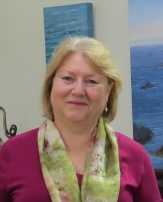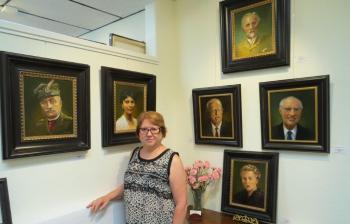


Artist’s works will be auctioned to benefit East County Magazine and Grossmont Hospital Foundation
By Miriam Raftery
November 18, 2015 (San Diego) – The paintings of Countess Jadwiga “Inka” Zamoyska of Zamość are stunning depictions of nature and portraits with a masterful application of light and shadows to create mystery, dramatic effects and beauty. Her works evoke the style of Rembrandt, the 17th century Old Master famed for his illuminating imagery.
That similarity is no accident. Like Rembrandt, Countess Zamoyska comes from a European family and has endured her share of life challenges, finding therapy in her first love, art. “My passion to paint is fueled by the ever-changing beauty that, if we let it, confronts us at every turn,” she states. “When I see it, I crave to raise it to canvas.”
Astonishingly, her current portfolio of exquisite portraits, still life, landscapes, seascapes and snow scenes have all been created in the past few years—and next up, this remarkably talented artist has agreed to create a painting of East County wilderness which will be auctioned on November 20th with proceeds benefitting both Grossmont Hospital Foundation and launch of a new special section on East County Magazine covering animal rescue groups and wildlife/animal news in our region. She will also paint a custom animal painting to be auctioned at a December 5th party for the animals, also benefitting our new “Animal Action” section..
Descended from near-royalty who resided in a palace in Poland, now a museum depicted in a coffee table volume in her Carlsbad studio, Countess Zamoyska’s regal lineage began with an ancestor who was a knight pierced by three lances at the battle of Plowsce in 1331. He recovered and was rewarded for his bravery by the King of Poland; the family coat of arms depicts a trio of lances—symbols of God, honor and country.
Zamoyska’s family history reads like an action-adventure novel, making it clear where the artist draws strength, courage and a passion for life.
The Zamoyski Family, historically very political and progressive, starting with Jan Zamoyski in the 16th Century who served as rector of Padua University and returned to Poland to build the renaissance city of Zamość that is now on the UNESCO World heritage List. He also created the second university in Poland and served the nation as Grand Royal Chancellor and Hetman for Life. The history of the family includes two more Royal Chancellors, a President of the Senate, a foreign minister, a senator and currently Zamoyska’s cousin, multli-term elected Mayor of Zamość.
Zamoyska’s great-uncle, Count Konstanty Zamoyski, was sent to study in Paris, the hub of Polish nobility fomenting revolution against the foreign-imposed tri-partition and occupation of Poland. He died childless and left his estate to her grandfather, Count Adam Zamoyski(photo, top of story).
 Her father, Count Aleksander Zamoyski (photo, left), also a lord, survived World War I, the Russian Revolution, the Polish-Soviet War (when he was wounded and highly decorated), and served as a cavalry officer in World War II, when he later became active in the resistance and was arrested by the Gestapo, tortured in Lublin Castle and sent to Auschwitz to be executed.
Her father, Count Aleksander Zamoyski (photo, left), also a lord, survived World War I, the Russian Revolution, the Polish-Soviet War (when he was wounded and highly decorated), and served as a cavalry officer in World War II, when he later became active in the resistance and was arrested by the Gestapo, tortured in Lublin Castle and sent to Auschwitz to be executed.
“This is more than anyone should endure in a lifetime,” Zamoyska told East County Magazine in an exclusive interview.
He was saved after Zamoyska’s mother, Countess Jadwiga Zamoyska, sent a courier across Europe seeking help. Baron Gustaf Mannerheim, her father’s commanding officer in St. Petersburg before the Russian Revolution, was now the President of Finland and intervened directly with Hitler to save Zamoyska’s father’s life. He was transferred to Dachau prison, where he survived by “using his brain and trusting God; he would write poetry, do math and write letters to his family in his mind,” Zamoyska says. He was ultimately freed when U.S. troops arrived and rejoined his regiment in Italy.
Meanwhile Zamoyska’s mother and siblings fled the Soviet front for Warsaw, where they joined the Warsaw Uprising. Her oldest brother was wounded in combat.
“After the failed insurrection and almost complete devastation of Warsaw, 85% destroyed, my family was on the Soviet hit list and were on the run,” Zamoyska says.
The family was reunited in Italy in 1946, then transported to England. After two years, they emigrated to Canada and bought a farm in Quebec, where Zamoyska was born. But the farming venture failed, and the family moved to Montreal, where her father became an accountant until his health deteriorated and he died in 1961. Her mother became a physical education teacher. She died in 1998, at the age of 90. Both were active in Canada’s Polish-Canadian community promoting Poland’s  freedom from communism, though deeply saddened that they could never return to their homeland.
freedom from communism, though deeply saddened that they could never return to their homeland.
Countess Zamoyska’s family also had extensive artistic talent. Her mother’s side included many accomplished artists and her father’s family includes the world famous sculptor, Count August Zamoyski.
It was customary in privileged families of the nobility to learn several art disciplines, but being a professional artist was simply not acceptable,” she observes. “I said I wanted to go to art school; there was a deadpan look on my mother’s face.”
Zamoyska was accepted to Ryerson PolyTech Toronto where she aspired to study commercial art. But in fear of being a starving artist, she transferred to the School of Business. After marrying and moving to the USA, she attended Rochester Institute of Technoloy obtained her BSc in accounting, and becoming a CPA. She enjoyed her work with various clients as a tax manager but her health suffered.
“I had chronic migraines that derailed my career and my marriage,” she recalls. “I ended up in a hospital in Boston and had a revelation.” She envisioned herself “floating in the universe. I could imagine how beautiful it was and all I wanted was to paint the beauty. Quickly, I realized that I could only paint it by physically holding a brush—that could only be possible in this lifetime. The doctors said `Your art is your health.’”
 She began to paint early on in life, first with her mother’s coaching then in high school, four years of studio art. At that time post-modern expressionism was the trend, and Zamoyska feels that she missed out on the traditional classical training. It is after meeting and studying with Russian master Regina Lyubovnaya of Los Angeles does she feel imbued with a classical approach to painting. Lyubovnaya did extensive art studies including many years with internationally recognized as a “20th Century Old Master” David A. Leffel. Mr. Leffel, a true master of chiaroscuro (light and shadows) teaches ‘the art of painting’ and not simply the technique of painting.
She began to paint early on in life, first with her mother’s coaching then in high school, four years of studio art. At that time post-modern expressionism was the trend, and Zamoyska feels that she missed out on the traditional classical training. It is after meeting and studying with Russian master Regina Lyubovnaya of Los Angeles does she feel imbued with a classical approach to painting. Lyubovnaya did extensive art studies including many years with internationally recognized as a “20th Century Old Master” David A. Leffel. Mr. Leffel, a true master of chiaroscuro (light and shadows) teaches ‘the art of painting’ and not simply the technique of painting.
“Up to this point I painted in oil in an impressionistic style using palette knife technique focusing on landscapes with many works done ‘en plein air’ (outdoors). After my introduction to Regina almost three years ago and attending her master classes, I have become passionate about the logic of light and its use in creating illusion in painting,” Zamoyska explains. “This classical training is what I have been yearning for since those art studio days in high school. This in depth knowledge of light has opened the doors for me into painterly abstract realism.”
She reflects, “With Regina I started working on still life paintings. The response I got to my paintings is that there is something solidly beautiful and it resonates with human beings.
Her still life paintings are remarkable, iridescent glass glistening as light draws the viewer’s eye directly into the painting.
 During her life-long art practice she delved into painting landscapes, seascapes, and winter scenes. Living in cold climates in upstate New York, Toronto, Montreal and London, she says, “I just love winter, cold weather and snow.” Her winter scenes capture the frozen beauty with a sublime blend of white and blue hues. She has also created dramatic seascapes as well as pastoral landscapes including vineyards in Temecula , Cuyamaca oaks, and other Southern California scenes.
During her life-long art practice she delved into painting landscapes, seascapes, and winter scenes. Living in cold climates in upstate New York, Toronto, Montreal and London, she says, “I just love winter, cold weather and snow.” Her winter scenes capture the frozen beauty with a sublime blend of white and blue hues. She has also created dramatic seascapes as well as pastoral landscapes including vineyards in Temecula , Cuyamaca oaks, and other Southern California scenes.
A year ago, she began painting portraits and from the first portrait, her mentor, Lyubovnaya, exclaimed, “you have found your calling,” Zamoyska recalled, adding, “I believe it is true.” Her first portraits depict her family members who have passed on. Like portraits by Rembrandt, Zamoyska’s are remarkably life-like, filled with emotion highlighted by the dramatic use of light.
“Rembrandt is a genius at keeping his paintings mysterious and he does that by keeping the background dark which makes the light radiate out of the painting. Rembrandt uses the light to lead you into the painting and have your eyes feast on the focal point,” she says, likening the technique to a musical crescendo that builds to a dramatic conclusion.
Zamoyska uses only the highest quality oil paints, such as Old Holland, rich in pigment with no fillers, costing as much as $70 for a small tube. Some ingredients may soon no longer be available, such as cadmium, a heavy metal, making her works even more valuable as collector’s items.
The Countess, who owns the Zamoyska Fine Arts studio and gallery in Carlsbad, also teaches art and accepts commissions, with portrait commission fees running thousands of dollars and deservedly so. The quality of her work is rare in modern times, particularly in the New World, and her artworks deserve to be treasured.
Thus far, Zamoyska has painted still life, scenics and portraits. East County Magazine is delighted to announce that she has agreed to create two unique paintings as a donation to benefit our nonprofit media outlet. A painting of Cuyamaca will be auctioned at a November 20th event by the American Polish Cooperation Society and Sharp Hospital Foundation. Proceeds from the auction of Zamoyska’s painting will benefit launch of a new Animals Action section at East County Magazine highlighting works of animal rescue groups in our region , as well as wildlife and animal-related local stories. Then on December 5th, a special animal portrait created by Zamoysa for the occasion will be auctioned at a “Party for the Animals” to benefit our new “Animal Action” section on East County Magazine.
Two dog paintings (left and right) by her mentor/instructor Regina Lyubovnaya will also be available in the auction.
To view Countess Zamoyska’s remarkable portraits and other works, visit http://inkazamoyskafinearts.com/.
The American Polish Cooperation Society aspires to help those less fortunate, strengthen American-Polish relations and promote charitable good works to make positive, significant impacts for a brighter future for both countries. To attend the November 20th event or learn more about the Polish American Cooperation Society, visit www.APCS.com.PL .
East County Magazine’s mission is to reflect all voices in our community, especially those under-represented in other media, also helping to publicize the good works done by community groups such as the APCS, Grossmont Hospital Foundation, animal rescue organizations and more. We also publish the East County Wildfire and Emergency Alerts, sponsored by the Grossmont Healthcare District, helping to keep people safe and informed across our region.
East County Magazine is a proud sponsor of the America Polish Cooperation Society’s event on behalf of the Grossmont Hospital Foundation. To learn more about East County Magazine, a publication of the nonprofit 501c3 Heartland Coalition, or inquire about the auctions, visit www.EastCountyMagazine.org









Recent comments